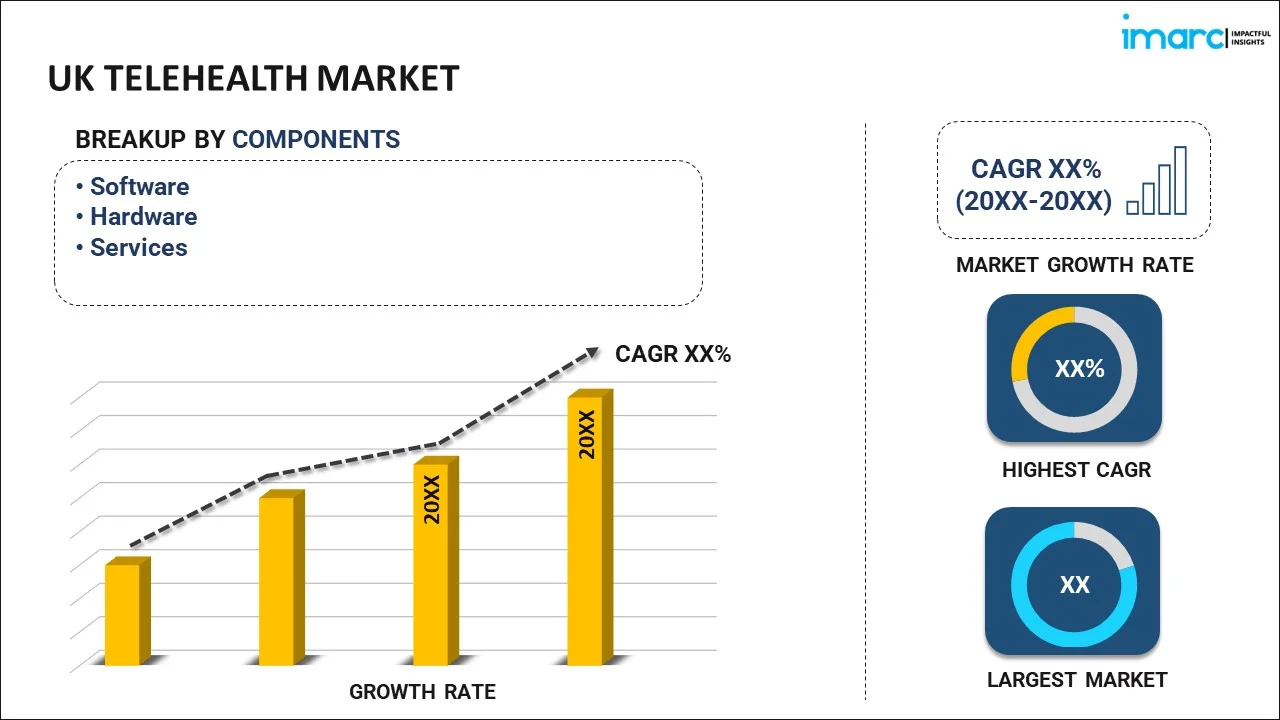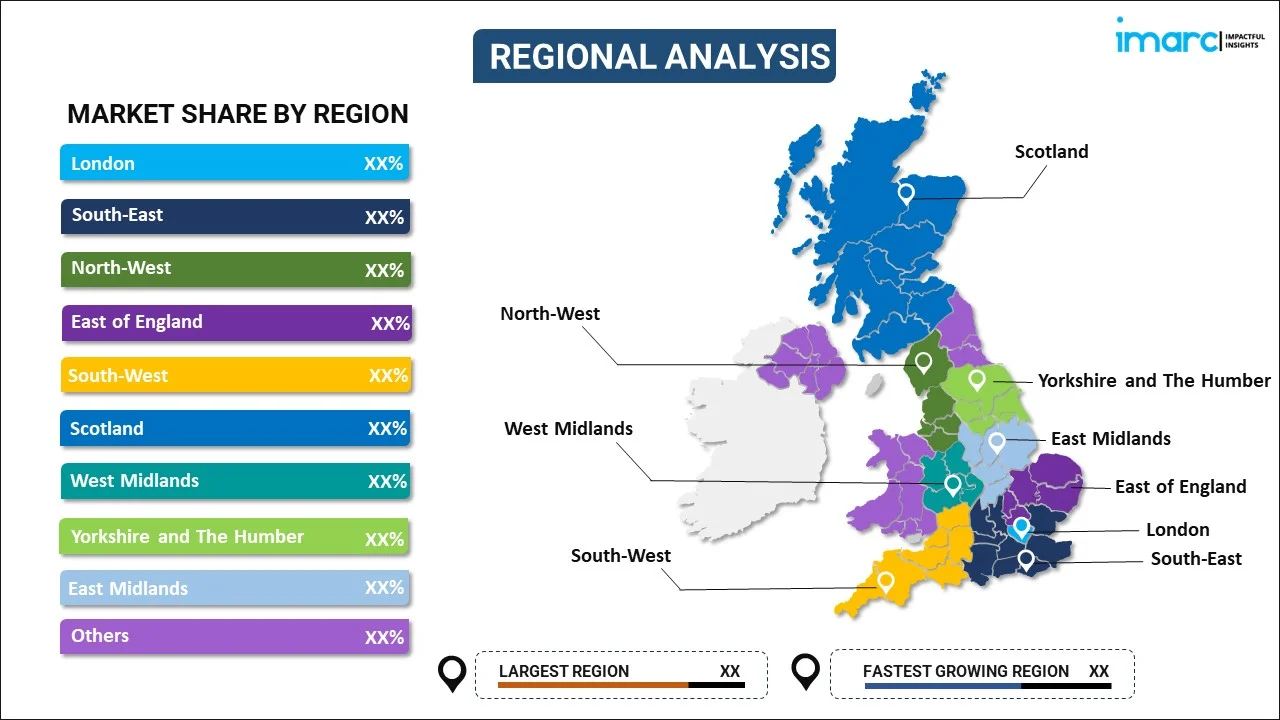
UK Telehealth Market Report by Component (Software, Hardware, Services), Communication Technology (Video Conferencing, mHealth Solutions, and Others), Hosting Type (Cloud-based and Web-based, On-premises), Application (Teleconsultation and Telementoring, Medical Education and Training, Teleradiology, Telecardiology, Tele-ICU, Tele-Psychiatry, Tele-Dermatology, and Others), End User (Providers, Patients, Payers), and Region 2024-2032
UK Telehealth Market Overview:
The UK telehealth market is projected to exhibit a growth rate (CAGR) of 17.70% during 2024-2032. The market is propelled by the increased demand for remote healthcare services, the development of sophisticated telecommunication technologies including high-speed internet, advanced video conferencing tools, and secure data transmission, and government support and policy initiatives.
|
Report Attribute
|
Key Statistics
|
|---|---|
|
Base Year
|
2023 |
|
Forecast Years
|
2024-2032
|
|
Historical Years
|
2018-2023
|
| Market Growth Rate (2024-2032) | 17.70% |
UK Telehealth Market Trends:
Increasing Demand for Remote Healthcare
One of the key drivers of the UK telehealth market is the growing demand for remote healthcare services. As per the National Library of Medicine, recent surveys have shown a 45%–70% drop in patient visits across the USA, UK and other European nations. Simultaneously, the COVID-19 pandemic has forced providers to adopt telehealth solutions, dramatically accelerating the adoption of digital health platforms. The COVID-19 epidemic expedited the development of telemedicine, as both patients and healthcare providers attempted to reduce physical contact and follow social distancing protocols. This highlighted telehealth's convenience and effectiveness in providing medical consultations, follow-up care, and even certain types of therapy. Remote healthcare services have proven to be particularly useful for controlling chronic diseases, mental health issues, and post-operative care. Patients welcome the reduction in travel and waiting times, while healthcare providers may reach a larger patient base and streamline operations.
Government Policies
Government funding and policy actions have a substantial impact on the UK telehealth market. The National Health Service (NHS) has actively promoted the use of telehealth to improve healthcare accessibility and lessen the demand on physical healthcare facilities. During the pandemic, the UK government implemented a number of measures to encourage the rapid adoption of telehealth, including regulatory changes that increased flexibility in telehealth services and reimbursement regulations. The U.S. Food and Drug Administration, Health Canada and U.K. Medicines and Healthcare Products Regulatory Agency published "Good Machine Learning Practice for Medical Device Development: Guiding Principles" in 2021 to help standardize principles across the regions. Besides, the U.K.'s National Health Service AI Lab launched its National Strategy for AI in Health and Social Care to support the development of AI-driven technologies. The government has also invested in strengthening digital infrastructure to facilitate telehealth services, particularly in rural and underserved areas. Initiatives like the NHS Long Term Plan emphasize the relevance of digital health solutions in modernizing the healthcare system and improving patient care.
UK Telehealth Market News:
- July 2023: Plan Your Baby, a London-based startup launched new telehealth fertility clinic in the UK to provide fertility support.
The company provides online consultations, treatment, end-to-end pregnancy clinical monitoring, access to in-person clinics for diagnostic tests and access to 90 locations for ultrasound scans. - June 2023: The Government of England planned a Digital NHS Health Check to be delivered to one million across England from next spring. The Department of Health and Social Care (DHSC) underlined that the current face-to-face NHS health check for adults in England aged 40-74 had helped to prevent 400 heart attacks and strokes.
UK Telehealth Market Segmentation:
IMARC Group provides an analysis of the key trends in each segment of the market, along with forecasts at the country level for 2024-2032. Our report has categorized the market based on component, communication technology, hosting type, application, and end user.
Component Insights:

- Software
- Hardware
- Services
The report has provided a detailed breakup and analysis of the market based on the component. This includes software, hardware, and services.
Communication Technology Insights:
- Video Conferencing
- mHealth Solutions
- Others
A detailed breakup and analysis of the market based on the communication technology have also been provided in the report. This includes video conferencing, mHealth solutions, and others.
Hosting Type Insights:
- Cloud-based and Web-based
- On-premises
The report has provided a detailed breakup and analysis of the market based on the hosting type. This includes cloud-based and web-based and on-premises.
Application Insights:
- Teleconsultation and Telementoring
- Medical Education and Training
- Teleradiology
- Telecardiology
- Tele-ICU
- Tele-Psychiatry
- Tele-Dermatology
- Others
A detailed breakup and analysis of the market based on the application have also been provided in the report. This includes teleconsultation and telementoring, medical education and training, teleradiology, telecardiology, tele-ICU, tele-psychiatry, tele-dermatology, and others.
End User Insights:
- Providers
- Patients
- Payers
The report has provided a detailed breakup and analysis of the market based on the end user. This includes providers, patients and payers.
Regional Insights:

- London
- South East
- North West
- East of England
- South West
- Scotland
- West Midlands
- Yorkshire and The Humber
- East Midlands
- Others
The report has also provided a comprehensive analysis of all the major regional markets, which include London, South East, North West, East of England, South West, Scotland, West Midlands, Yorkshire and The Humber, East Midlands, and Others.
Competitive Landscape:
The market research report has also provided a comprehensive analysis of the competitive landscape. Competitive analysis such as market structure, key player positioning, top winning strategies, competitive dashboard, and company evaluation quadrant has been covered in the report. Also, detailed profiles of all major companies have been provided.
UK Telehealth Market Report Coverage:
| Report Features | Details |
|---|---|
| Base Year of the Analysis | 2023 |
| Historical Period | 2018-2023 |
| Forecast Period | 2024-2032 |
| Units | Million US$ |
| Scope of the Report | Exploration of Historical Trends and Market Outlook, Industry Catalysts and Challenges, Segment-Wise Historical and Future Market Assessment:
|
| Components Covered | Software, Hardware, Services |
| Communication Technologies Covered | Video Conferencing, mHealth Solutions, Others |
| Hosting Types Covered | Cloud-based and Web-based, On-premises |
| Applications Covered | Teleconsultation and Telementoring, Medical Education and Training, Teleradiology, Telecardiology, Tele-ICU, Tele-Psychiatry, Tele-Dermatology, Others |
| End Users Covered | Providers, Patients, Payers |
| Regions Covered | London, South East, North West, East of England, South West, Scotland, West Midlands, Yorkshire and The Humber, East Midlands, Others |
| Customization Scope | 10% Free Customization |
| Post-Sale Analyst Support | 10-12 Weeks |
| Delivery Format | PDF and Excel through Email (We can also provide the editable version of the report in PPT/Word format on special request) |
Key Questions Answered in This Report:
- How has the UK telehealth market performed so far and how will it perform in the coming years?
- What has been the impact of COVID-19 on the UK telehealth market?
- What is the breakup of the UK telehealth market on the basis of component?
- What is the breakup of the UK telehealth market on the basis of communication technology?
- What is the breakup of the UK telehealth market on the basis of hosting type?
- What is the breakup of the UK telehealth market on the basis of application?
- What is the breakup of the UK telehealth market on the basis of end user?
- What are the various stages in the value chain of the UK telehealth market?
- What are the key driving factors and challenges in the UK telehealth?
- What is the structure of the UK telehealth market and who are the key players?
- What is the degree of competition in the UK telehealth market?
Key Benefits for Stakeholders:
- IMARC’s industry report offers a comprehensive quantitative analysis of various market segments, historical and current market trends, market forecasts, and dynamics of the UK telehealth market from 2018-2032.
- The research report provides the latest information on the market drivers, challenges, and opportunities in the UK telehealth market.
- Porter's five forces analysis assist stakeholders in assessing the impact of new entrants, competitive rivalry, supplier power, buyer power, and the threat of substitution. It helps stakeholders to analyze the level of competition within the UK telehealth industry and its attractiveness.
- Competitive landscape allows stakeholders to understand their competitive environment and provides an insight into the current positions of key players in the market.
Need more help?
- Speak to our experienced analysts for insights on the current market scenarios.
- Include additional segments and countries to customize the report as per your requirement.
- Gain an unparalleled competitive advantage in your domain by understanding how to utilize the report and positively impacting your operations and revenue.
- For further assistance, please connect with our analysts.
 Inquire Before Buying
Inquire Before Buying
 Speak to an Analyst
Speak to an Analyst
 Request Brochure
Request Brochure
 Request Customization
Request Customization




.webp)




.webp)












